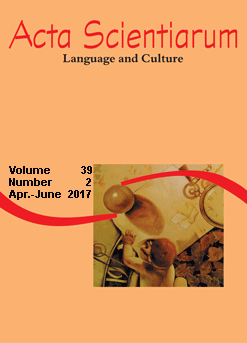<b>A categoria de aspecto em algumas línguas indígenas do Brasil
Resumen
O objetivo do artigo é analisar, com base no modelo da Gramática Discursivo-Funcional, GDF (Hengeveld e Mackenzie, 2008), as noções de aspecto nas línguas indígenas das famílias Aruak (Kinikinau), Jê (Parkatejê, Xerente e Xavante), Guató (Guató), Tupi-Guarani (Asurini), Boróro (Boróro), Karib (Ikpeng), Pano (Katukina, Matis e Shanenawa) e Ofayé (Ofayé), considerando-se o princípio de ordenação das categorias de tempo, aspecto e modo (TAM) com relação ao predicado da oração, bem como as relações semânticas de escopo entre tais categorias gramaticais quanto aos níveis e às camadas da GDF. Como resultados, verificamos que o aspecto qualitativo (perfectivo, imperfectivo etc.) tende a se posicionar mais próximo ao verbo, justamente por alterar a constituição temporal interna do estado de coisas, ao passo que o aspecto quantitativo (habitual, por exemplo) e o tempo tendem a se posicionar um pouco mais distantes do predicado, pelo fato de funcionarem como modificadores do estado de coisas como um todo. Já as noções de modo tendem a se colocar mais distantes do verbo, por não afetarem diretamente o seu estatuto. Comprovamos ainda que a distribuição das categorias TAM tende a respeitar a ordenação e as relações de escopo entre elas, como diz Hengeveld (2011): (modo(tempo(aspecto(predicado+argumentos)))).
Descargas
DECLARAÇÃO DE ORIGINALIDADE E DIREITOS AUTORAIS
Declaro que o presente artigo é original, não tendo sido submetido à publicação em qualquer outro periódico nacional ou internacional, quer seja em parte ou em sua totalidade.
Os direitos autorais pertencem exclusivamente aos autores. Os direitos de licenciamento utilizados pelo periódico é a licença Creative Commons Attribution 4.0 (CC BY 4.0): são permitidos o acompartilhamento (cópia e distribuição do material em qualqer meio ou formato) e adaptação (remix, transformação e criação de material a partir do conteúdo assim licenciado para quaisquer fins, inclusive comerciais.
Recomenda-se a leitura desse link para maiores informações sobre o tema: fornecimento de créditos e referências de forma correta, entre outros detalhes cruciais para uso adequado do material licenciado.




















6.png)









